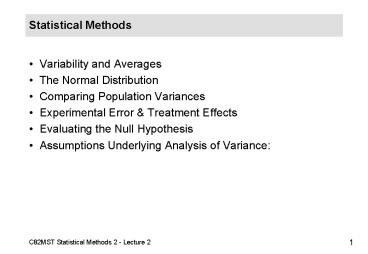Statistical Methods - PowerPoint PPT Presentation
1 / 23
Title:
Statistical Methods
Description:
Statistical Methods Variability and Averages The Normal Distribution Comparing Population Variances Experimental Error & Treatment Effects Evaluating the Null Hypothesis – PowerPoint PPT presentation
Number of Views:42
Avg rating:3.0/5.0
Title: Statistical Methods
1
Statistical Methods
- Variability and Averages
- The Normal Distribution
- Comparing Population Variances
- Experimental Error Treatment Effects
- Evaluating the Null Hypothesis
- Assumptions Underlying Analysis of Variance
2
Variability and Averages
Patients
Controls
- Graph 1 Bipolar disorder
- Different variability
- Same averages
- Graph 2 Blood sugar levels
- Same variability
- Different averages
Frequency
Depressed Manic
Patients
Controls
Frequency
Low
High
3
The Normal Distribution
- The normal distribution is used in statistical
analysis in order to make standardized
comparisons across different populations
(treatments). - The kinds of parametric statistical techniques we
use assume that a population is normally
distributed. - This allows us to compare directly between two
populations
4
The Normal Distribution
- The Normal Distribution is a mathematical
function that defines the distribution of scores
in population with respect to two population
parameters. - The first parameter is the Greek letter (m, mu).
This represents the population mean. - The second parameter is the Greek letter (s,
sigma) that represents the population standard
deviation. - Different normal distributions are generated
whenever the population mean or the population
standard deviation are different
5
The Normal Distribution
- Normal distributions with different population
variances and the same population mean
6
The Normal Distribution
- Normal distributions with different population
means and the same population variance
f(x)
7
The Normal Distribution
- Normal distributions with different population
variances and different population means
2
s
1
1
m
2
s
3
3
m
8
Normal Distribution
- Most samples of data are normally distributed
(but not all)
9
Comparing Populations in terms of Shared Variances
- When the null hypothesis (Ho) is approximately
true we have the following - There is almost a complete overlap between the
two distributions of scores
10
Comparing Populations in terms of Shared Variances
- When the alternative hypothesis (H1) is true we
have the following - There is very little overlap between the two
distributions
11
Shared Variance and the Null Hypothesis
- The crux of the problem of rejecting the null
hypothesis is the fact that we can always
attribute some portion of the difference we
observe among treatment parameters to chance
factors - These chance factors are known as experimental
error
12
Experimental Error
- All uncontrolled sources of variability in an
experiment are considered potential contributors
to experimental error. - There are two basic kinds of experimental error
- individual differences error
- measurement error.
13
Estimates of Experimental Error
- In a real experiment both sources of experimental
error will influence and contribute to the scores
of each subject. - The variability of subjects treated alike, i.e.
within the same treatment condition or level,
provides a measure of the experimental error. - At the same time the variability of subjects
within each of the other treatment levels also
offers estimates of experimental error
14
Estimate of Treatment Effects
- The means of the different groups in the
experiment should reflect the differences in the
population means, if there are any. - The treatments are viewed as a systematic source
of variability in contrast to the unsystematic
source of variability the experimental error. - This systematic source of variability is known as
the treatment effect.
15
An Example
- Two lecturers teach the same course.
- Ho lecturer does not influence exam score.
- Experimental design
- 10 students 5 assigned to each lecturer.
- IV Lecturer (A1, A2)
- DV Exam score
- Results
- A1 16, 18, 10,12,19
- A1 Mean15
- A2 4, 6, 8, 10, 2
- A2 Mean6
16
Partitioning the Deviations
17
Partitioning the Deviations
- Each of the deviations from the grand mean have
specific names - is called the total deviation.
- is called the between groups
deviation. - is called the within subjects
deviation. - Dividing the deviation from the grand mean is
known as partitioning
18
Evaluating the Null Hypothesis
- The between groups deviation
- represents the effects of both error and the
treatment - The within subjects deviation
- represents the effect of error alone
19
Evaluating the Null Hypothesis
- If we consider the ratio of the between groups
variability and the within groups variability - Then we have
20
Evaluating the Null Hypothesis
- If the null hypothesis is true then the treatment
effect is equal to zero - If the null hypothesis is false then the
treatment effect is greater than zero
21
Evaluating the Null Hypothesis
- The ratio
- is compared to the F-distribution
22
ANOVA
- Analysis of variance uses the ratio of two
sources of variability to test the null
hypothesis - Between group variability estimates both
experimental error and treatment effects - Within subjects variability estimates
experimental error - The assumptions that underly this technique
directly follow on from the F-ratio.
23
Assumptions Underlying Analysis of Variance
- The measure taken is on an interval or ratio
scale. - The populations are normally distributed
- The variances of the compared populations are the
same. - The estimates of the population variance are
independent































